Fly-drive: Mexico City to Cancún
Temples and pyramids against a backdrop of natural beauty
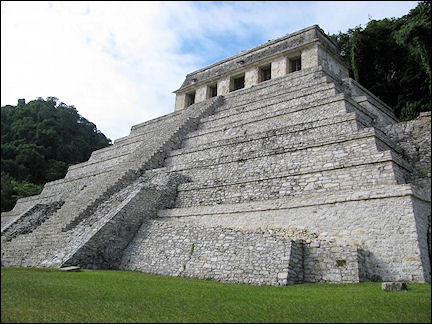
|
A 3,100 kilometers family trip by rental car from Mexico City via Puebla eastward to Oaxaca, Tehuantepec and San Cristobal. To Palenque and Bonampak and then north to Campeche, Chichen-Itza, Izamal, San Felipe and Rio Lagartos. Finally, via Cancún to Puerto Morales. On the way they visit Maya temples and pyramids, swim near waterfalls, in underground ponds and in the sea. They also acquaint themselves with local traditions and quirks.
Text and photos: Rob De Langhe
Mexico City
Maya architecture in the ancient capital Teotihuacan
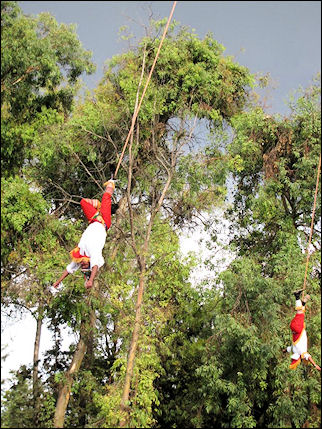
|
We are stared at as if we're aliens when we stroll through Mexico City, also in the subway. We visit the house of the famous artist Frieda Kahlo in the clean Coyoacán section.
After a jugo (freshly squeezed juice of ripe fruit) in a family restaurant, we visit the anthropological museum, which is great, but our jet lag is getting the better of us.
When we leave the museum, we have to take shelter from a heavy thunderstorm. We see the voladores, or "flying men", who plunge from a thirty meters high pole in traditional festive garb and then "fly" suspended from ropes. This ritual is part of the Totonake culture.
We get up early to visit the archeological site of the ancient Mexican capital Teotihuacan. We take the subway to Indios Verdes, where the long- distance buses leave from a huge open-air market, where you can find anything, including food, between dirt and filth.
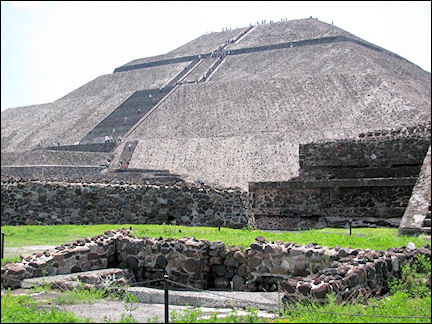
|
The bus drives through slums. Sometimes the road is level between potholes and bumps. There are no official bus stops, but there are places where people are waiting for the bus. We see incredibly many peddlers and stalls along the road and in villages.
The Teotihuacan archeological site is our first experience with Maya architecture: huge pyramids on the two kilometers long Avenue of the Dead, surrounded by temples and houses of high officials; with a healthy dose of imagination the buildings are recognizable as such.
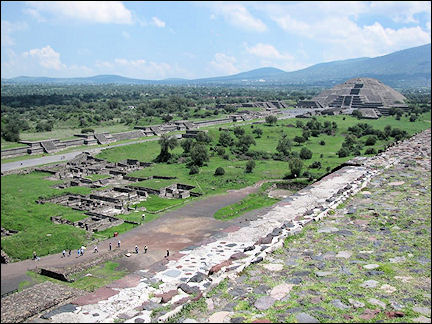
|
The Pyramid of the Sun invites a climb. After 226 steps you have a wonderful overview of the ancient city, which must have been enormous. One third has so far been dug up and is accessible, the rest is covered by trees and the surrounding houses, which have walls made of stones that look suspiciously like the ones of the ancient ruins.
The beggars here aren't pushy at all; they sell plastic junk, like everywhere. When we see a very old Mexican we understand that this is their only source of income and buy a souvenir from him anyway.
From Mexico City to Puebla
Cactuses so high they look like telephone poles
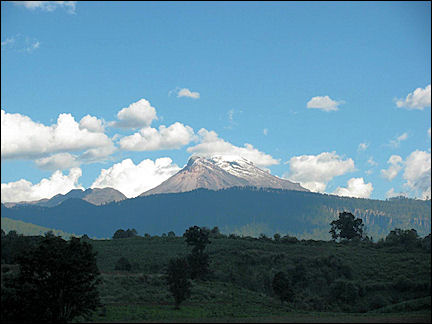
|
In the afternoon we pick up the rental car at our hotel. The salesman makes it clear that we'll have to pay hell for every scratch. It's a behemoth of an American car, which has been parked with help of a shoehorn between the other cars in the small parking lot behind the hotel. There's no avoiding it, we have to leave for the next ciry, Puebla.
Despite the busy traffic it's not too hard to get out of Mexico City. Just outside the city (50 kilometers farther) we drive between open fields with farmers who work the land with horses and hand-ploughs.
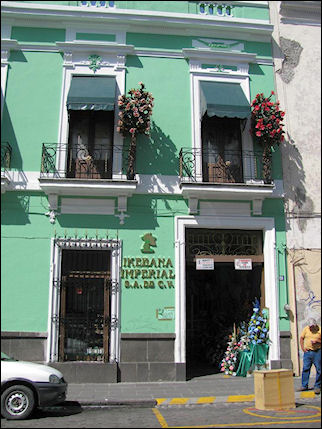
|
The mountains aren't very high, that would be impossible since we already are at an altitude of 1,500 meters. Cactuses so high they look like telephone poles, overgrow complete mountain slopes. Eagles float in the air everywhere.
Near Puebla we see the Nevado de Toluca volcano with the volcano lakes Lago del Sol and Lago de la Luna. Past the Mexico City plain the weather detetiorates and we arrive in Puebla during a loud thunder- and rainstorm. Hotel Colonial turns out to be a former Jesuit monastery with large room with high ceilings, a fantastic glass roof and a roof terrace with views of the city and surroundings.
The next morning we see our first zocalo (central square with trees, and benches; every city has one).
There are many smelly cars, no recognizable traffic rules and there are cops everywhere. Trucks and delapidated buses spew smoke and soot. There are very cheap stores and there is a beautiful and huge cathedral.
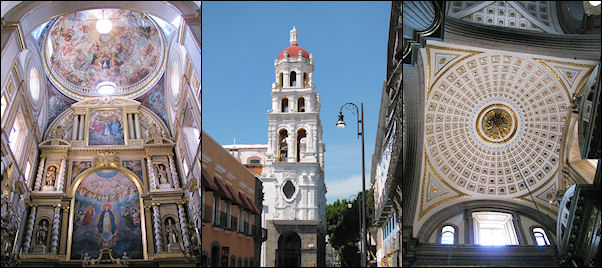
The streets and sidewalks are clean and the colonial buildings are painted in warm southern colors. This is a ceramics region, so we buy a large colorful bowl.
I visit the open-air railway museum with my son Frederik: you can go inside almost all carriages, many of which are beautifully restored. Considering the annual budget, those restorations must have begun fifty years ago.
From Puebla to Oaxaca, Monte Albán
Pollo con Mole is a must if you're visiting here
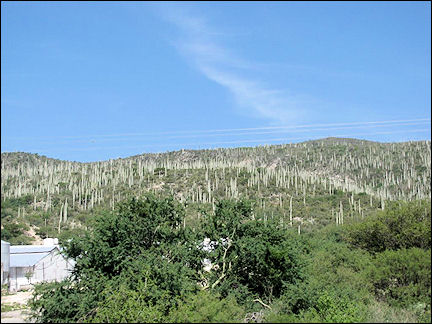
|
This morning we travel on to Oaxaca. It's a long ride through a bare region full of typical tall cactus-pincushion-hills.
Oaxaca turns out to be a smelly city and our hotel is on a busy street in the city center. There is a lively zocalo by the cathedral.
We have dinner in a wonderful restaurant, Casa de la Abuela, on the second floor of a building on the zocalo. We zit close to the balcony and have a view of a dance festival outside, right below us. We have the local speciality: Pollo con Mole (chicken with chocolate sauce), a must if you are visiting here.
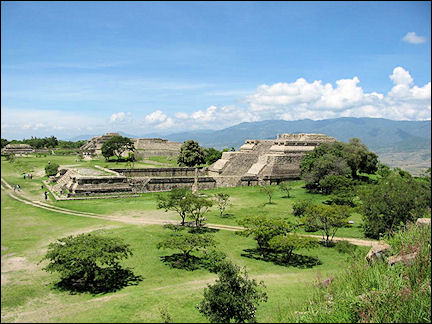
|
The next morning we hurry to Pedro and Alberto: we load mountain bikes on a pick-up truck and drive to the high-lying Monte Albán, which has a large pre-Columbian archeological site.
Monte Albán is strategically located. There are few foreign tourists. A hole in the staircase of a temple allows the sunshine to get in on the longest day of the year, which helped the Mayas to establish their annual calender.
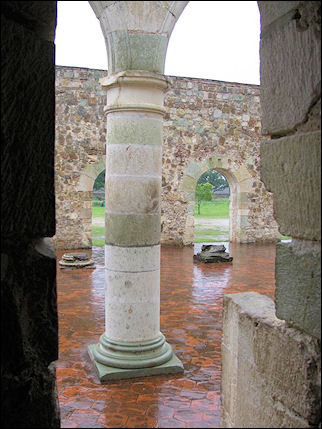
|
After this excursion we take the bikes and zip through the woods back to the city, armed with a piece of paper with faded lines that serves as a map. On the way we pass through hamlets with slum dwellings, but people are always friendly and curious about our weird looks.
During a stop in Cuilapan de Guerrero we buy fresh pineapple at the convent and are given a big bag of chili powder to "spice up" the pineapple.
Just when we want to get on our bikes again, a tropical downpour begins and we have to take shelter in the ruins of the convent, in a portal with stairs to the pulpit. When it's dry, we bicycle through deserted fields to Zaachila, where we have a wonderful meal from one of three stews that are offered in a road restaurant, watched by three dogs, two roosters, five chickens and a cat.
From Oaxaca to Tehuantepec
All cemetaries look festive
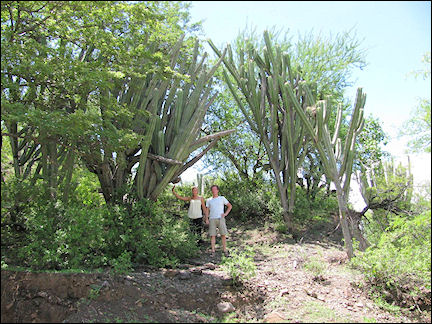
|
The next morning we buy cookies at the bakery and eat them on the zocalo. People are busy creating a carpet of flower petals in colorful patterns on the square.
We drive to Tehuantepec, direction Pacific Ocean, through mountains and valleys, about 300 kilometers on a winding road.
The cactuses look different here, but are at least as large as the ones we saw before. We pass through poor villages with colorful houses, surrounded by flower gardens; the streets are green and every cemetary we pass, looks festive. Maya-Mexicans decorate graves, because the dead are lucky enough to have entered the world of the gods.
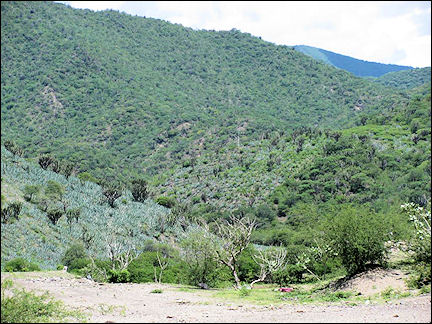
|
First we meander over the mountains. Little by little we descend to sea level, which we notice because of the temperatures: when we open de car windows just before our arrival, a hot, damp wind enters the car.
Tehuantepec is the 'matriarchal' city of Mexico: men have no authority here, women wear the pants. Considering their sturdy appearance, it's probably best to do as they tell you.
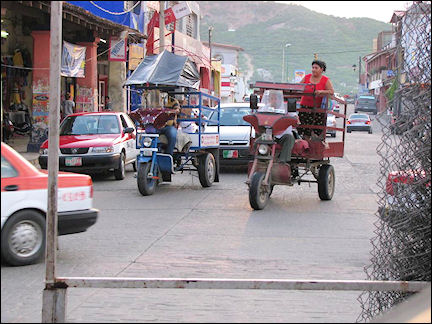
|
I get up at 6 AM and go for a run along the road, between overgrown fields and bushes. Homocidal maniacs in cars speed by, too close for comfort. A dead sheep lies on the side of the road; an emaciated horse looks cluelessly at me; there are remains of what used to be a discotheque and poor people are already cutting reeds at this hour.
There isn't a lot to see in Tehuantepec, so we drive to the sea. We pass Salina Cruz, a navy base, driving on a pothole-road along slums and former beach café's until we reach the dyke. The deserted beach is white, wide and kilometers long. There are four other cars and some surfers have fun with the waves.
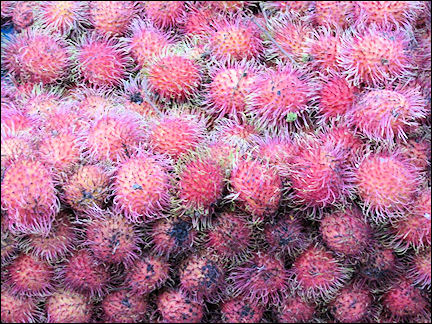
|
We run into the sea for a refreshing swim, but the water is at least 27-28 degrees centigrade. The wind rises and our feet are almost sandblasted.
In the evening we return to Tehuantepec's city center. Two women teams play a volleyball match on the market square, while next to them a brass band is rehearsing with drums and trumpets.
We buy tote bags and a kind of lychees with long-haired skins, again very sweet. We also see fresh vegetables, but the clouds of flies and wasps keep us from buying any.
From Tehuantepec to San Cristobal
Soldiers search the car for drugs

On the way to San Cristobal the next day we pass an incredibly big windmill park, it must be the largest in the Americas. The electricity is sold to neighboring Guatemala, the Mexicans themselves have frequent power outages.
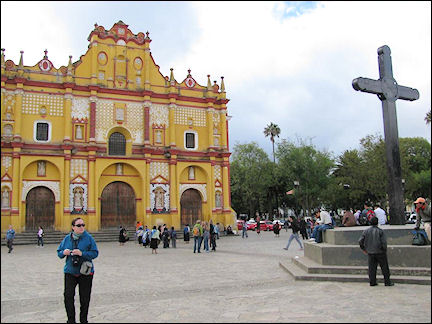
|
Our trip goes swiftly, until we are stopped by a group of soldiers, just before the Ariago/Tuxtla junction; they search the car for drugs. When they find the dirty socks and underwear of our daughter Nele, we are quickly allowed to move on.
At 9:15 AM the next morning we are on the square in front of the cathedral, boarding a mini-van for an excursion to the villages Chamula and Zaachila. The exubarantly talking driver Raoul first takes us to Chamula.
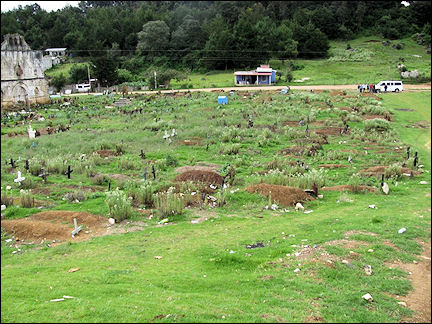
|
Our guide Manuel is waiting for us at the cemetary. He tells us that only the date of death is put on the crosses, births are not registered here. It's unknown how many children people have because of this.
It's a macho culture: polygamy, no contraception (except that women put some black wool from their skirts into their vaginas before having sex). Girls are married of for 8000 pesos when they turn 15.
Frederik and I take a stroll on the little market on the square in front of the church. Inside the church we watch the adoration of a patron saint and praying people; there are candles on the floor, which is covered with pine needles.
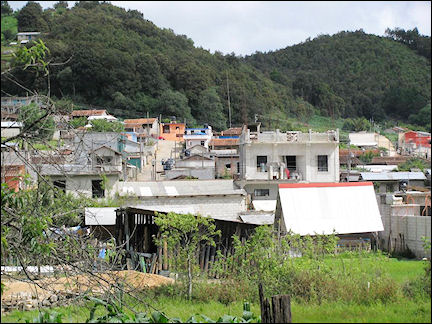
|
An old female shaman pours home-brewed poch (strong liquor) on herbs and then lets the concoctian flow over the head of a sick woman, after which she waves a live chicken over the candles and then smoothly wrings its neck.
In Zaachilla we visit a family in their little house of concrete and dried mud. The women are weaving cloths in the courtyard and baking tortillas on a large stone which is covered with mortar diluted in water. It works like Teflon.
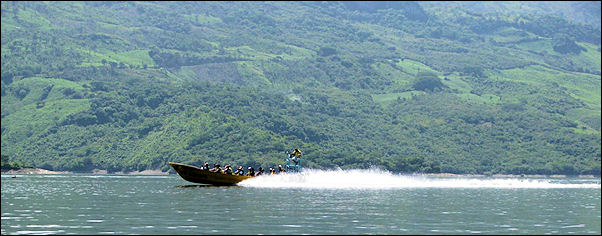
The following day we leave early for Cañón del Sumidero in eco- park Sumidero. In Chiapa we board long, narrow motorboats, densely packed in the dock and waiting for passengers.
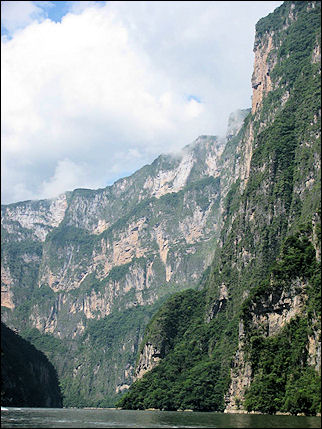
|
We race over the water through the canyon and see crocodiles sunbathe on the bank.
We pass exquisite lime deposits on the wall of rock, shaped like giants shells and fomrmed by a small waterfall.
The cañón is impressive with its 900 meters high walls. There is an abundance of pelicans and white herons.
Afterwards I have coffee with my wife Chantal in Café Museo, a co-operative that supports local coffee farmers. Here the influnence of the Zapatistos is still noticeable: people want to help the poor by means of support organizations.
Palenque
The archeological site is located in an impressive jungle
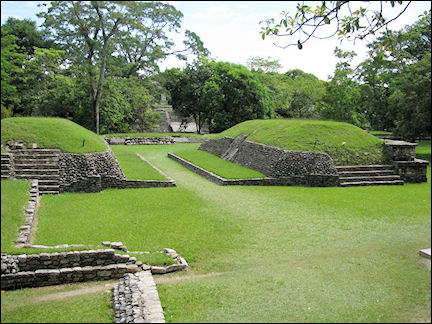
|
The archeological site of Palenque is located in an impressive jungle, where a battle is still being waged against the overgrowing of the temples. There are lots of people, but they disappear between the trees, beautiful flowers and decaying temples and pyramids.
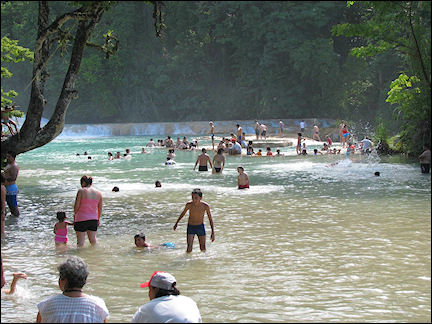
|
We don't stay very long, the waterfalls of Agua Azul beckon us. On the last path before the waterfalls we have to drive very slowly because of a thunderstorm that makes the road almost invisible. Young Juan, I think he's not older than 7 years, offers to guard our car for 5 pesos. Almost everyone is swimming in one guarded pond with a diameter of about 150 meters, where the current is safe.
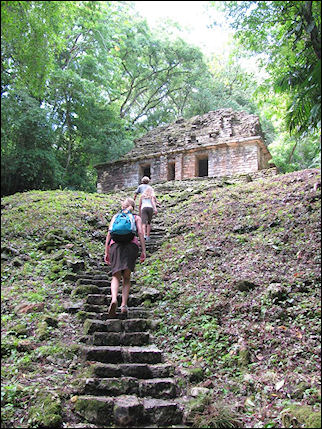
|
The next morning a mini-van takes us to the starting point of a boat excursion to Yaxchilan. This town used to be an important trade post for the Maya, for their trade in valuable goods (like cocoa beans) from Central America: Guatemala, Costa Rica and farther away.
After 45 minutes of sailing on the Usumacinta river, which is the border between Mexico and Guatemala, we arrive at a pontoon where we walk into the jungle.
A hundred percent humidity and 38 degrees centigrade. We see lots of critters in the jungle on and around the half dug up ruins of Yaxchilan and also flowers and lianas as thick as arms. The site with few tourists looks mysterious.
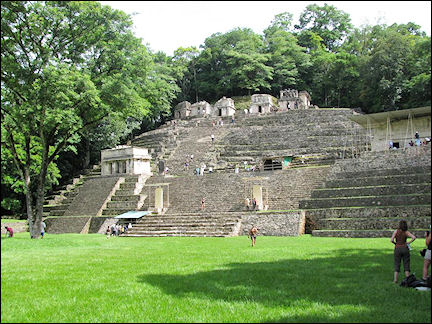
|
We continue on to Bonampak archeological site. We have to get in line to look for a few seconds at the remaining Maya frescoes.
From Palenque to Campeche
A festive market on the zocalo
On the way to Campeche we pass vast agave plantations. Agave is a succulent the juice of which is used in making tequila.
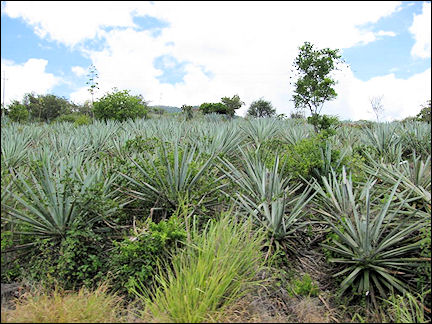
|
After leaving Chiapas we soon see how different the province of Campeche is: hardly any poor Indian hamlets along the road, less and lower topes (speed bumps that are all over the place; there are rarely warning signs, making you brake hard and suddenly).
We drive on the long coastal road along the Gulf of Mexico to Campeche, along a polluted bay with brown stinking water but still with lots of pelicans and other birds.
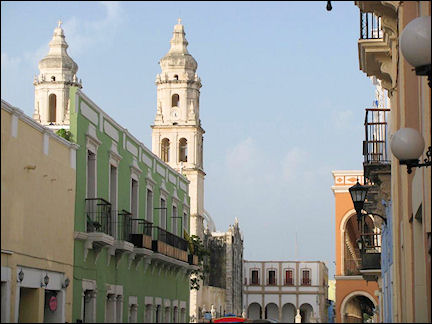
|
The food on second floor terrace by the zocalo in Casa Vieja is way too expensive (950 pesos) and the servings are too small for us hungry Belgians. But the backdrop is wonderful with a festive market on the zocalo and the cathedral in the background.
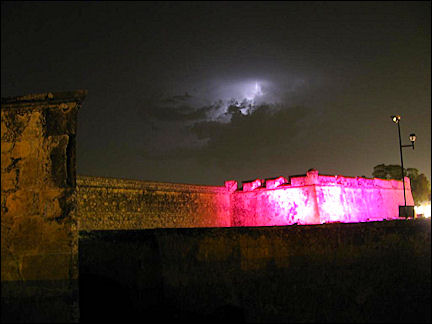
|
We attend a free sound and light show at the old city walls (Puerto de Tierra) which tells how the town was defended against pirates in the past, while in the background lightning from a far away thunderstorm shoots through the clouds.
From Campeche to Izamal
Bombs to celebrate the god-of-the-day
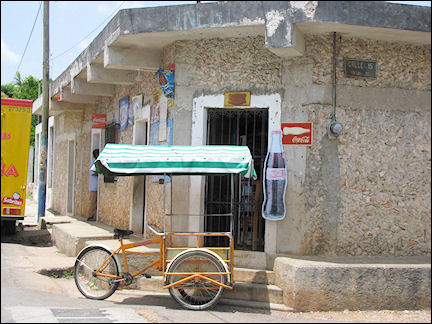
|
It's a swift journey to Izamal, on a level road with hardly any topes, through a vast landscape. We arrive in Izamal at 2 PM. No tourist to be seen, except for us. The hotel, in an oasis of green and quiet a few streets removed from the village center, has a wonderful ecological garden and a modest swimming pool, the bottom of which is made with giant rocks.
Parrot Oscar is waiting next to our table on the terrace until we give him something to eat. Bamboo grows meters high in the garden with exotic plants and fountains. Unfortunately there are also lots of mosquitos.
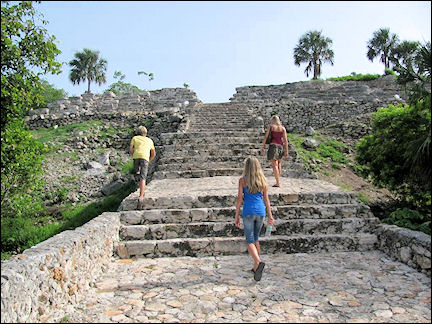
|
Nele has fun with the three cats, which catch a lizard and play with it as if it were a mouse, until we find the tail and a hindleg of the lizard a little later next to a path. After dinner we explore the village, where eight policemen are busy directing traffic: about twenty cars and forty bikes.
At night we hear rockets. Only the next morning I find out what they were for: not fireworks, but a kind of little bombs with which the Maya celebrate their god-of-the-day.
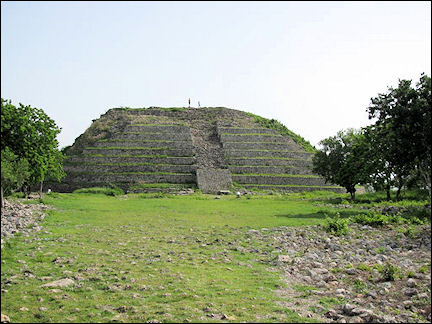
|
Exactly at a quarter to nine in the morning two carriages stop in front of our hotel. We take a one-and-a-half hours trip through narrow streets, along two large pyramids in the village center, which are half-way torn down... and again we regocnize those missing stones in the fronts and walls of surrounding buildings.
In the afternoon we go to swim in two cenotes (underground ponds). First the one in Yokdzonot, hidden in the forest and made accessible by Indian women who exploit it as an ecological attraction. It is a large hole in the ground (maybe 50 meters diameter), filled with groundwater. We descend via wooden stairs to the water, about 45 meters below the edge of the pit.
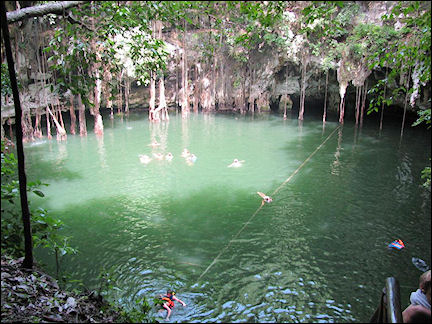
|
The water teems with black fish, you feel them frequently during swimming. The water has a pleasant temperature and the roots of the trees above us hang over the edge of the pit, a full 45 meters down, searching for water.
Beautifully colored birds that look like quetzal, fly to and from their nests in the caverns just above the water surface and behind the clusters of tree roots.
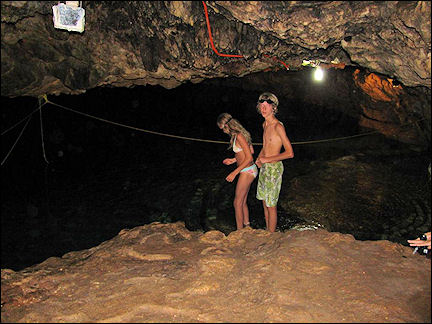
|
The Chihuan cenote in the village of Holca is really underground: along slippery, self carved stairs we arrive in a cave which is illuminated by a few lamps. Squeaky clean, pleasant water; we swim in the cave, together with ten other Flemish. We can't see the bottom nor the back of the cave; on the ceiling we see a few bats.
From Izamal to Chitchen Itza
Giant iguanas are sunbathing
We drive 50 kilometers to Chitchen Itza the next day. It is the main attraction for tourists in Yucatán. We can't find the autostrada, so we drive on secondary roads between fields to this city.
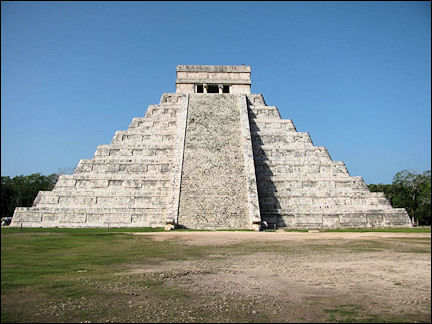
|
In our hotel's garden are a few big ceiba trees, the famous Maya Tree of Life: it reaches 10 meters above ground, its roots reach a depth of 15 meters and its trunk is filled with water.
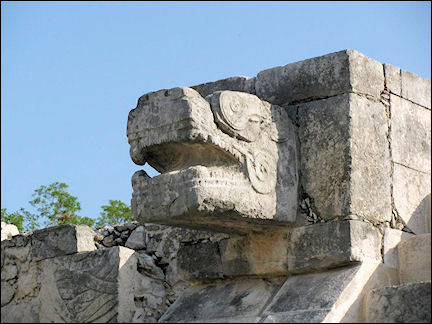
|
We go to watch the light show on the archeological site, which we of course share with droves of other tourists. When it's over and the grounds are almost deserted, we enjoy in silence the fabulous starry sky.
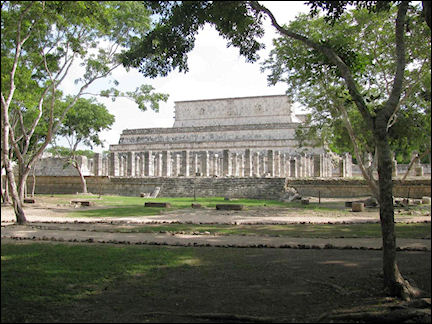
|
To beat the heat and tourist crowds at it, we walk to the back entrance of the Chitzen Itza archeological site at 7:45 AM. It's only a short walk from our hotel. The site is known for its great variety in architectural styles.
We enjoy ourselves for two hours on the almost deserted site. There are lots of birds, that make exotic sounds.
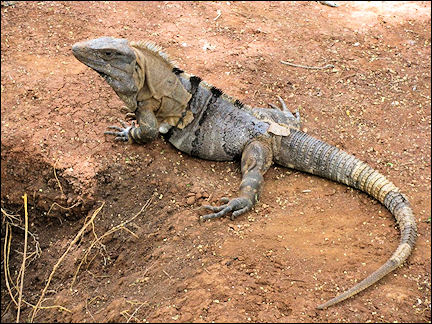
|
None of the ancient structures are yet accessible for tourists. It is impressive when you think that all of this was built a thousand years ago. We see a couple of giant iguanas who are sunbathing. Around noon the tourists arrive, our cue to leave.
From Chitchen Itza to Rio Lagartos
The guide drops a horseshoe crab on Iris' head
With the scratch-free return of our car tomorrow in Cancún in mind, we drive carefully on our last but one trip to the north of Yucatán, to the fishers village of Rio Lagartos.
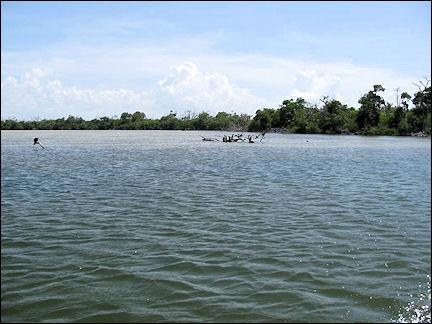
|
We stop in one of the many PeMex (Petroleum Mexico) gas stations to inflate our tires. I have to go in reverse to the air compressor. I don't look out and ram the fender into a concrete pole.
We are half an hour early for a boat ride in the Rio Lagartos laguna, so I ask around if someone knows anything about fenders. No, they don't, but the captain of our boat knows Jesús and Jesús has a friend in Cancún who owns a garage.
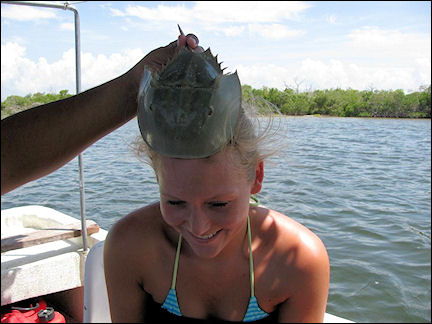
|
The five of us and a guide ride in a fast boat over the laguna, to Rio Lagartos and the flamengoes. On the way the boat suddenly stops in shallow water and the man searches the water with his hands, then pulls up a horseshoe crab: a scary animal with an oval shell of 20 centimeters diameter and eight swarming legs.
According to the man the Maya used the animal for head masages, then drops the animal on Iris' head.
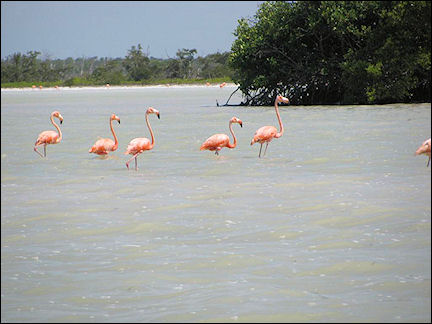
|
A little further we see a crocodile lazying about between the mangroves on the bank and we find our first flamengoes. Fun fact, new to us: they are shocking pink because they eat nothing but shrimp.
A little farther we see even more flamengoes and then push our boat on the bright white sandy bank between the laguna and the salt pits.
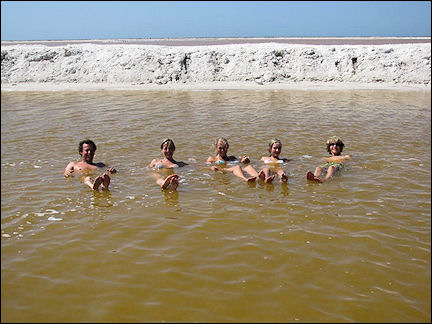
|
There we can float for five minutes in a brook that is brown from the salt in it. Our guide makes with his hand a 20 centimeters deep hole in the sand and brings up sticky salt mud with which he covers us from head to toe.
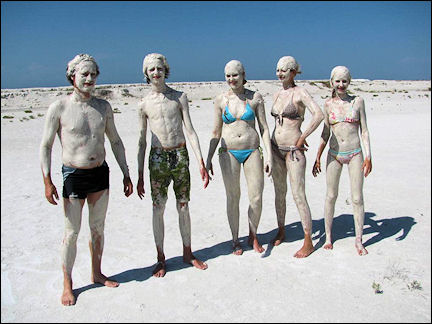
|
We sail back to the big laguna while the mud dries and begins to itch. We dock on an island where we rinse our selves in the warm, clear seawater. Our skin feels like that of a newborn baby.
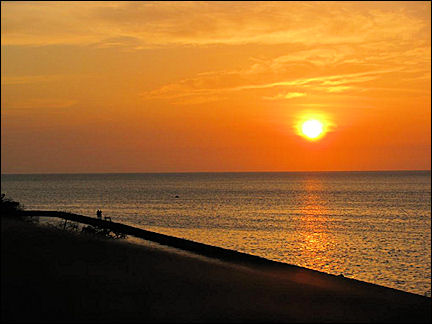
|
The excursion is well planned: we dock at the seafood restaurant owned by the same guys that own the boats. No problem at all, because the fish is tasty and the meal very cheap.
From Rio Lagartos to Puerto Morelos
A stingray tears the nerve to my big toe
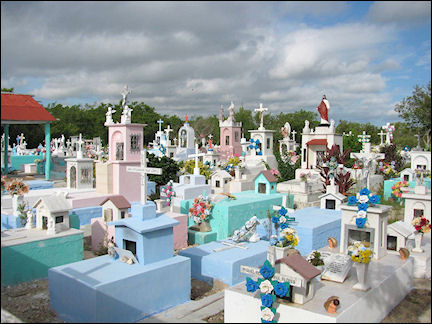
|
We leave picturesque Rio Lagartos and drive along a colorful cemetary to the toll road, eastward to Cancún. Like everywhere in Yucatán it is deserted: only tourists pay toll, everyone else uses the secondary roads through villages.
In Cancún the road is all of a sudden crowded. It's hard to find the village of Puerto Morelos, 15 km farther south. The entrance to our hotel is heavily guarded, you don't enter without being registered. The drugs wars in Mexico have consequences.
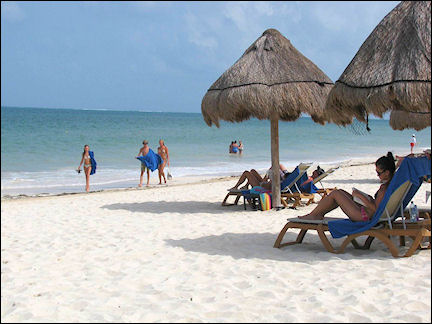
|
We quickly drop the luggage in our rooms and Chantal and I take the rental car to the mechanic in Cancún. His garage turns out to be located in one of the remote slums. Three quarters of his house and garage were destroyed in the 2005 hurricane Wilma. The cars on his property belong in the junkyard. His most used tool is a gas burner.
And he is going to make our luxury rental car scratch-free. It's a miracle: 300 pesos pulling out the stops later the fender shines as new. Incredible. We return the car without any problem and take a bus and a taxi back to the hotel, where we are going to enjoy our last week here.
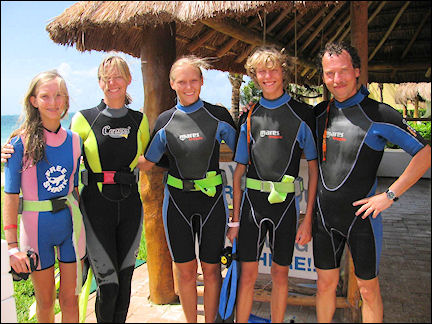
|
Frederik and Nele make their first dives in the sea with their newly obtained diving certificates. The helpful owner of the diving center helps Chantal get over her fear of taking off her diving goggles underwater, so we finally can make a family dive with the five of us.
I succeed in stepping on a stingray in the surf, probably breaking its back, but in a last reflex the animal lashes his tail with hook-end into my foot and tears the nerve to my big toe. I have never suffered so much pain in my life and spend the last days in Mexico with a swollen foot.